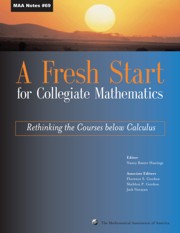Book contents
- Frontmatter
- Preface
- Contents
- Introduction
- Background
- Theme 1 New Visions for Introductory Collegiate Mathematics
- Theme 2 The Transition from High School to College
- Theme 3 The Needs of Other Disciplines
- Theme 4 Student Learning and Research
- Theme 5 Implementation
- Theme 6 Influencing the Mathematics Community
- Ideas and Projects that Work: Part 1
- Ideas and Projects that Work: Part 2
Ideas and Projects that Work: Part 2
- Frontmatter
- Preface
- Contents
- Introduction
- Background
- Theme 1 New Visions for Introductory Collegiate Mathematics
- Theme 2 The Transition from High School to College
- Theme 3 The Needs of Other Disciplines
- Theme 4 Student Learning and Research
- Theme 5 Implementation
- Theme 6 Influencing the Mathematics Community
- Ideas and Projects that Work: Part 1
- Ideas and Projects that Work: Part 2
Summary
This volume focuses on challenges that need to be met and changes that need to be made. Repeatedly authors have stressed the importance of emphasizing conceptual understanding, instead of rote manipulations; the importance of focusing on situations where mathematics is used in the real world, instead of on rinky-dink word problems; the importance of utilizing the methods of data analysis, instead of relegating it to the last chapter (if it.s there at all); and the importance of fostering an active learning environment, where students ask what-if type questions, make connections, explore mathematical ideas, and work collaboratively instead of sitting passively copying notes off the board. The good news is that our colleagues are grappling with how to do this. Projects are being developed. New texts are being written. Alternative pedagogies are being implemented. The authors of the following papers are at the forefront of this movement. But, they are not alone. They are simply the ones who came to mind when we started this project over three years ago. We apologize to those of you who do not appear in this collection. You are here in spirit and are an important part of this movement of change.
The Mathematics in Action project aims to empower college mathematics students with a real-world math-ematical literacy that will provide a solid foundation for future study in mathematics and other disciplines.… The project's goal to empower students mathematically focuses on developing desired student outcomes in five main areas: number sense, symbolic sense, a general function sense, a thorough linear function sense and a sense of nonlinear relationships. […]
- Type
- Chapter
- Information
- A Fresh Start for Collegiate MathematicsRethinking the Courses below Calculus, pp. 329 - 332Publisher: Mathematical Association of AmericaPrint publication year: 2006



